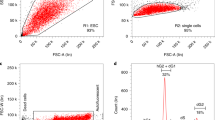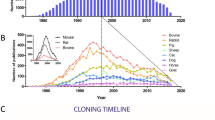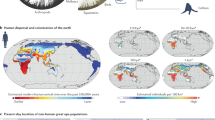Abstract
Mice have been cloned by nuclear transfer into enucleated oocytes1,2,3, and here we describe the reiterative cloning of mice to four and six generations in two independent lines. Successive generations showed no signs of prematureageing, as judged by gross behaviouralparameters, and there was no evidence of shortening of telomeres at the ends of chromosomes, normally an indicator of cellular senescence — in fact, these appeared to increase slightly in length. This increase is surprising, given that the number of mitotic divisions greatly exceeds that of sexually produced animals and that any deleterious effects of cloning might be expected to be amplified in sequentially cloned mice. Our results offer a new approach to the study of organismal ageing.
This is a preview of subscription content, access via your institution
Access options
Subscribe to this journal
Receive 51 print issues and online access
$199.00 per year
only $3.90 per issue
Buy this article
- Purchase on Springer Link
- Instant access to full article PDF
Prices may be subject to local taxes which are calculated during checkout

Similar content being viewed by others
References
Wakayama, T., Perry, A. C. F., Zuccotti, M., Johnson, K. R. & Yanagimachi, R. Nature 394, 369–374 (1998).
Wakayama, T. & Yanagimachi, R. Nature Genet. 22 , 127–128 (1999).
Wakayama, T., Rodriguez, I., Perry, A. C. F., Yanagimachi, R. & Mombaerts, P. Proc. Natl Acad. Sci. USA 96, 14984–14989 (1999).
Tamashiro, K. L., Wakayama, T., Blanchard, R. J., Blanchard, D. C. & Yanagimachi, R. Biol. Reprod. 63, 328–334 ( 2000).
Zijlmans, J. M. et al. Proc. Natl Acad. Sci. USA 94, 7423– 7428 (1997).
Shiels, P. G. et al. Nature 399, 316–317 (1999).
Lanza, R. P. et al. Science 288, 665–669 (2000).
Wilmut, I., Clark, J. & Harley, C. B. Nature Biotech. 18, 599– 600 (2000).
Author information
Authors and Affiliations
Corresponding author
Rights and permissions
About this article
Cite this article
Wakayama, T., Shinkai, Y., Tamashiro, K. et al. Cloning of mice to six generations. Nature 407, 318–319 (2000). https://doi.org/10.1038/35030301
Issue Date:
DOI: https://doi.org/10.1038/35030301
This article is cited by
-
Cellular reprogramming and epigenetic rejuvenation
Clinical Epigenetics (2021)
-
Healthy ageing of cloned sheep
Nature Communications (2016)
-
Unique features of mutations revealed by sequentially reprogrammed induced pluripotent stem cells
Nature Communications (2015)
-
Genome engineering in cattle: recent technological advancements
Chromosome Research (2015)
Comments
By submitting a comment you agree to abide by our Terms and Community Guidelines. If you find something abusive or that does not comply with our terms or guidelines please flag it as inappropriate.



